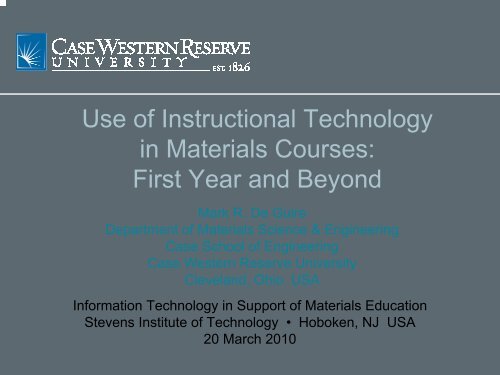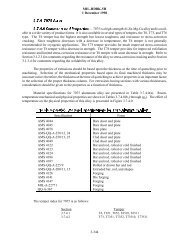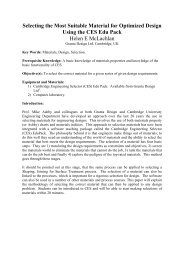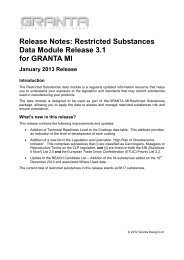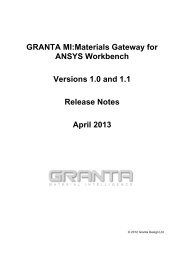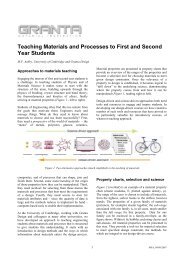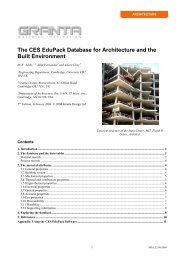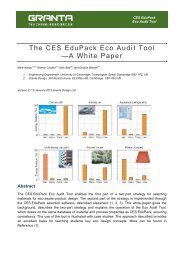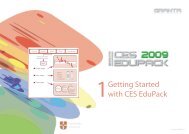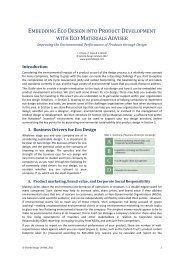First Year and Beyond - Granta Design
First Year and Beyond - Granta Design
First Year and Beyond - Granta Design
- No tags were found...
You also want an ePaper? Increase the reach of your titles
YUMPU automatically turns print PDFs into web optimized ePapers that Google loves.
Lecture videos — views per week (spring 2009)E1E4E2spring breakE3FEUsage highest …… during exam weeks… with less familiar material
Lecture videos — views per lecture (spring 2009)For 298 enrollees:Median number of views perlecture: ~85After first 4 weeks: ~75 viewsper lecture (average)“Hermiones”FEE4E3E2E1
Observations: InfoTech for a large first-yearcourse Challenge: keeping students engaged in large lectures Strategy: Vary the pace!• Demonstrations • Anecdotes • Videos• Chalk-talk • Document camera • Volunteers … Even demos over the document camera work Lecture attendance: ~50% Details on slides don’t transfer well to video make slides available to students
CES EduPack in a first-year courseThree required homework assignments (10% of grade):• #1: The interatomic potential & materials properties• “Scavenger hunt” • Melting point vs. thermal expansion• #2: Thermodynamics & materials processing• Embodied energy • Recycling• #3: Thermal, mechanical, electrical properties• Thermal & electrical conductivity (Wiedemann-Franz law)• Simple materials selection problemsIllustrating basic science with real materials
Melting temperature vs. thermal expansion• Start with Elements database• Primary vs. secondary bonding• Best fit?Thermal expansion coefficient at 300K (µstrain/°C)100010010120 50 100 200 500 1000 2000Melting temperature (K)
Melting temperature vs. thermal expansionSwitch to Level 1 database:• Trend is general• Materials clusterby category• Ranges vs.discrete valuesThermal expansion coefficient (µstrain/°C)2001005020105Polyethylene (PE)Lead alloysConcrete2500 1000 2000Melting point (K)
<strong>First</strong>-year undergraduate research projectWhat goes into “embodied energy”?• Sources of data• Variability of values• Specific materialsEmbodied energies for alternative-energy materials*• Photovoltaics• Fuel cell materials• Thermoelectrics• Batteries*) not in EduPack
2 nd - through 4 th -year students: Intro. to MS&E• Specificembodiedenergy, E e,m(J/kg)• Embodiedenergy perunit volume,E e,v = E e,m ρ(J/m 3 )
2nd- through 4 th -year students: Intro. to MS&E• Specificembodiedenergy, E e,m(J/kg)• Embodiedenergy perunit volume,E e,v = E e,m ρ(J/m 3 )• Annual energyconsumption,by material
2nd- through 4 th -year students: Intro. to MS&EPedagogical goal: translate design criteria tomaterials selection constraints (or objectives)Example*: A cylindrical rod 120 mm long <strong>and</strong>having a diameter of 15.0 mm is to be deformedusing a tensile load of 35.0 kN.35.0 kN15.0mmIt must experience neither• plastic deformation nor• reduction in diameter of more than1.2 x10 –2 mm.120 mmWhat materials are possible c<strong>and</strong>idates?*) From Callister, Materials Science & Engineering: anIntroduction
Re-express design criteria asconstraints on materials properties“No plastic deformation”⇒ applied stress < elastic limit (yield strength)⇒“Diameter reduction < 1.2 x 10 –2 mm”⇒
Graphical solution•Plot E/ν vs. σ y• Select fromhundreds ofmaterials,instead of4 or 5• Noticegroupings ofmaterials bycategory
More Intro. to EMSEThermal shockresistance:•Can groupmechanicalpropertiesvs. thermalproperties
Usage of CES EduPack in other coursesEBME 370: Principles of Biomedical Engineering <strong>Design</strong>EBME 380: Biomedical Engineering <strong>Design</strong> ExperienceEMAE 372: Relation of Materials to <strong>Design</strong>EMSE 303: Mechanical Behavior of MaterialsEMSE 313: Engineering Applications of MaterialsEMSE 421: Fracture of Materials
Senior design project: Triathlon bike frameKen Craymer, mechanicalengineeringMaterials selection criteria:• Young’s modulus• Specific yield strengthMaterial selected: Graphitefiber-reinforced polymer(GFRP)
Senior design project: Triathlon bike frameKen Craymer, mechanicalengineeringMaterials selection criteria:• Young’s modulus• Specific yield strengthMaterial selected: Graphitefiber-reinforced polymer(GFRP)
Senior design project: Torsion testing deviceAshley McKee,mechanical engineering:“I am working on designinga torsion testing device <strong>and</strong>I need to see what type oftorque we can expect toobtain for differentmaterials used in metallicbone screws in order tomake sure we buy a motorthat can withst<strong>and</strong> thesevalues.”
Senior design project: Minimally invasive tool to insertelectrodes for functional electrical stimulationJoseph Gabra, KatherineElhert, Robert Jiang, KennyNam, Jonathan Shaul,biomedical engineering:“The grooved teeth will help hold theelectrode. … when the tool is movinginto the patient the electrode iscontinually held <strong>and</strong> when the tool ispulled out the electrode is released.”
Senior design project: Minimally invasive tool to insertelectrodes for functional electrical stimulationJoseph Gabra, KatherineElhert, Robert Jiang, KennyNam, Jonathan Shaul,biomedical engineering:Materials selection criteria:• Yield strength• Fracture toughness• Flexural modulus• Fatigue stress• FDA approval for Class IIbioengineering• PriceMaterials: Stainless steel,titanium
AcknowledgmentsCase Western Reserve University LibrariesWilliam “Bud” Baeslack, CWRU ProvostNorman Tien, Dean of Case School of EngineeringCWRU Office of Instructional Technology <strong>and</strong>Computation<strong>Granta</strong>


